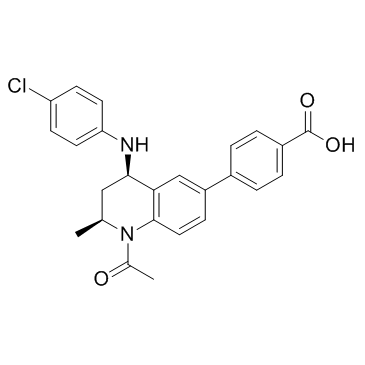1300031-52-0
| Name | i-bet726 |
|---|---|
| Synonyms |
4-((2S,4R)-1-acetyl-4-((4-chlorophenyl)amino)-2-methyl-1,2,3,4-tetrahydroquinolin-6-yl)benzoic acid
4-((2S,4R)-1-acetyl-4-((4-chlorophenyl)amino)-2-methyl-1,2,3,4-tetrahydro-6-quinolinyl)benzoic acid 4-{(2S,4R)-1-Acetyl-4-[(4-chlorophenyl)amino]-2-methyl-1,2,3,4-tetrahydro-6-quinolinyl}benzoic acid Benzoic acid, 4-[(2S,4R)-1-acetyl-4-[(4-chlorophenyl)amino]-1,2,3,4-tetrahydro-2-methyl-6-quinolinyl]- GSK1324726A |
| Description | GSK1324726A is a novel, potent, and selective inhibitor of BET proteins with high affinity to BRD2 (IC50=41 nM), BRD3 (IC50=31 nM), and BRD4 (IC50=22 nM). |
|---|---|
| Related Catalog | |
| Target |
IC50: 22 nM (BRD4), 31 nM (BRD3), 41 nM (BRD2)[1] |
| In Vitro | A panel of neuroblastoma cell lines are treated with GSK1324726A (I-BET726), and observed potent growth inhibition and cytotoxicity in most cell lines irrespective of MYCN copy number or expression level. All neuroblastoma cell lines tested exhibit potent growth inhibition, with a median growth IC50 value (gIC50; inhibitor concentration resulting in 50% growth inhibition) equal to 75 nM[1]. |
| In Vivo | GSK1324726A (I-BET726) inhibits neuroblastoma tumor growth. In the SK-N-AS model, mice in the vehicle group are euthanized on day 14 due to large tumor size. While there is no significant difference in tumor growth between the vehicle and GSK1324726A (5 mg/kg) group, 58% tumor growth inhibition (TGI) is observed in the GSK1324726A (15 mg/kg) group on day 14 of the study (n=9; p=0.006). Mice in the GSK1324726A (15 mg/kg) group are treated for an additional 7 days before tumor volume reaches a level comparable to that observed in the vehicle group, at which point the study is terminated. Tumors in the CHP-212 model grow much more slowly. After 42 days, tumors in vehicle-treated mice are only half the size those in the SK-N-AS model at the end of the study (Day 14). In the CHP-212 model, treatment with 5 mg/kg GSK1324726A results in TGI equal to 50% (n=8; p=0.1816), and mice in the 15 mg/kg group exhibits a TGI of 82% at the end of the study (n=5; p=0.0488)[1]. |
| Cell Assay | Cell line growth-death assays are performed with a few modifications. Briefly, cells are seeded into 384-well or 96-well plates at a density optimized for 6 days of growth. The following day, T0 measurements are taken using CellTiter-Glo, CellTiter-Fluor, or CyQuant Direct. Plates are read on an Envision, Safire 2, or SpectraMax Gemini EM plate reader. Remaining plates are treated with DMSO or a titration of GSK1324726A. Cells are incubated for 6 days and developed. Results are plotted as a percentage of the T0 value, normalized to 100%, versus concentration of compound. A 4-parameter equation is used to generate concentration response curves. Growth IC50 (gIC50) values are calculated at the mid-point of the growth window (between DMSO and T0 values). Ymin-T0 values are calculated by subtracting the T0 value (100%) from the Ymin value on the curve, and are a measure of net population cell growth or death[1]. |
| Animal Admin | Mice[1] CHP-212 (1×107) or SK-N-AS (5×106) cells in 100% matrigel are implanted subcutaneously into the right flank of approximately 9 week old female nude (Crl:CD-1-Foxn1 nu) mice. Tumors are measured with calipers and randomized using stratified sampling according to tumor size into treatment groups of 10 mice. GSK1324726A in vehicle or vehicle alone is administered orally by individual body weight at 10mls/kg. Mice are weighed and tumors are measured with calipers twice weekly, and mice are observed daily for any adverse treatment affects. Mice are euthanized using CO2 inhalation according to AVMA guidelines after two consecutive tumor measurements greater than 2500mm3, or if body weight loss greater than 20% is observed. For mouse pharmacodynamic studies, mice are euthanized as described above. Tumors are harvested from euthanized mice and placed in RNAlater for RNA isolation. Blood is collected after euthanasia via cardiac puncture. Rats[2] Male CD rats (253-283 g) are surgically prepared with implanted cannulae in the femoral vein (for GSK1324726A administration) and jugular vein (for blood sampling). Each rat receives Duphacillin (100 mg/kg s.c.) and Carprofen (7.5 mg/kg s.c.) as a pre-operative antibiotic and analgesic respectively. Each rat is allowed to recover for at least 2 days prior to dosing. Rats have free access to food and water throughout. Rat PK studies are conducted as a crossover design over 2 dosing occasions, with 3 days between dose administrations. Serial blood samples are taken (via indwelling jugular cannula) up to 26 h post dose administration on both dosing occasions. On study day 1, n=3 male rats each receives a 1 h intravenous infusion of GSK1324726A formulated in DMSO and 10% (w/v) KleptoseTM in saline (2%:98%) at a concentration of 0.2 mg/mL and the dose is filtered using a ca. 0.2 μm syringe filter unit. GSK1324726A is administered as a 1 h i.v. infusion at 5 mL/kg/h to achieve a target dose of 1 mg/kg. On study day 2, the same three rats each receives an oral administration of GSK1324726A suspended in 3% Pharmacoat 603/0.2% Sodium Lauryl Sulphate (w/v) aq. at a concentration of 0.6 mg/mL administered by gavage at 5 mL/kg to achieve a target dose of 3 mg/kg. At the end of the study the rats are euthanised by administration of sodium pentobarbital through the jugular vein cannula. |
| References |
| Density | 1.3±0.1 g/cm3 |
|---|---|
| Boiling Point | 707.3±60.0 °C at 760 mmHg |
| Molecular Formula | C25H23ClN2O3 |
| Molecular Weight | 434.915 |
| Flash Point | 381.6±32.9 °C |
| Exact Mass | 434.139709 |
| PSA | 69.64000 |
| LogP | 5.67 |
| Vapour Pressure | 0.0±2.4 mmHg at 25°C |
| Index of Refraction | 1.650 |
| Storage condition | -20℃ |
